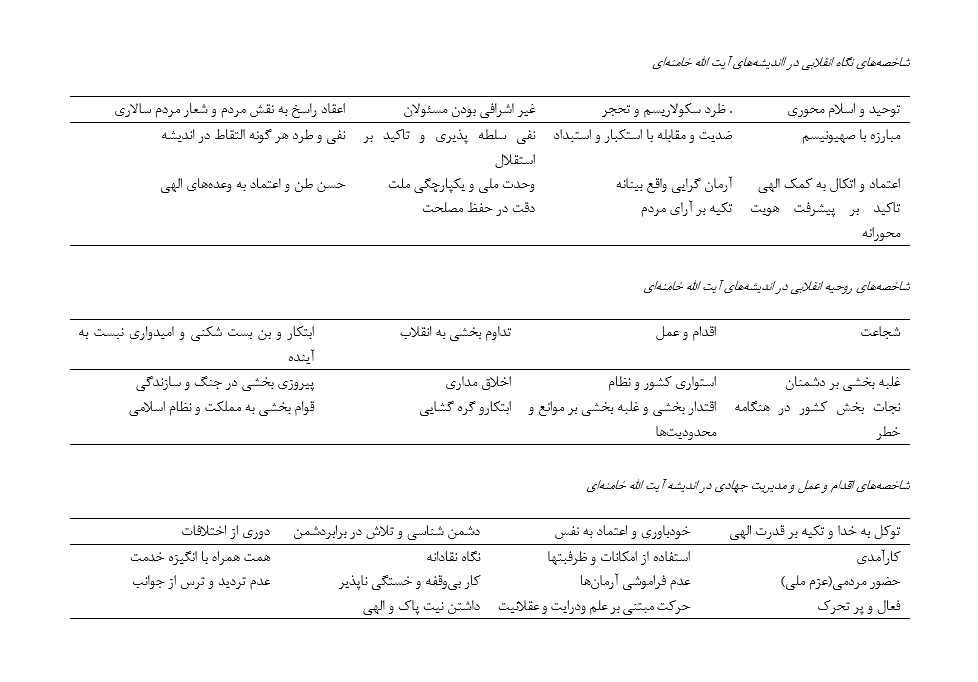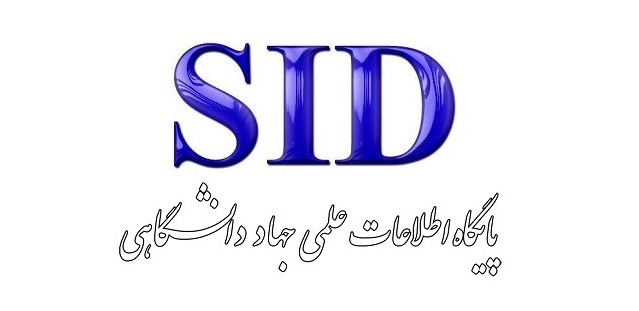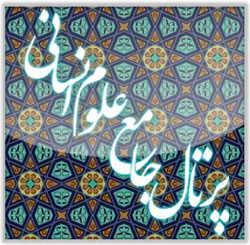Dimensions, Characteristics, and Features of the Revolutionary System in the Thought of Ayatollah Khamenei
Keywords:
System, Revolutionary system, Revolutionary outlook, Revolutionary spirit, Jihadi action and management, Second Step StatementAbstract
The theory of the revolutionary system is one of the most important elements of the second phase of the revolution's statement and a valuable experience from the first phase of the Islamic Revolution. It is in the statements of the leader of the revolution that whenever the system’s officials have paid attention to this concept, their actions have been successful, and whenever attention has been lacking, it has resulted in nothing but disappointment, stagnation, and regression. This research examines the dimensions, features, and characteristics of the revolutionary system from the perspective of Ayatollah Khamenei, the Supreme Leader of the Islamic Revolution. The research question is: What characteristics and features does the revolutionary system have in his words and thoughts, which are effective for the continuity and longevity of the revolution? In this study, we have used a descriptive and analytical method, relying on the statements of Ayatollah Khamenei to explain the features and components of the revolutionary system. Our hypothesis is that Ayatollah Khamenei considers the revolutionary system to have dimensions that define it, namely: 1) Revolutionary outlook or thought, 2) Revolutionary spirit, 3) Jihadi action, practice, and management. The theory of the revolutionary system is a theory related to action, the agent, and the structure, and it is thus concerned with actions that aim at self-building (the agent) and societal construction (the structure). Self-building, which is the first pillar of the revolutionary theory, is a highly influential and effective factor in the continuity of the revolution and in resisting the enemies of the revolution. According to Ayatollah Khamenei, the main cause of failure and defeat is the lack of self-building and being tainted by desires. Self-building must take place in two aspects: intellectual-belief and spiritual-ethical. In the second pillar of the revolutionary system theory, i.e., societal construction, after individuals have built themselves in various aspects, they must strive to build and shape their society. By shaping and finding their identity, they should form an Islamic family with a clear identity and ultimately shape an Islamic society. Finally, they must reach the most important pillar of the revolutionary system, which is the ultimate goal: the formation of the new Islamic civilization.
Downloads
References
Abdulrahman, A. (1997). Foundations of political science. Tehran: Sharifati Publications.
Abolhammadi, A. (1986). Foundations of politics. Tehran: Tosse Publications.
Dehghani Firouzabadi, S. J. (2012). Regional convergence theories and international regimes. Mokhatab Publications.
Dehkhoda, A. A. (1967). Dictionary. Tehran University.
Firahi, D. (2019). Political system and government in Islam. Samt Publications.
Ghorbani, M., & Mohammadal-Mouti, M. (2019). Dimensions, indicators, and requirements of the revolutionary system theory. 1.
Hajianzaei, M. R. (2017). The form and essence of the Islamic Revolution in the statements of the Supreme Leader of the Islamic Revolution. Tehran: Islamic Revolution Publications.
Helodi, M. (2016). The light of the future: Future studies of the Islamic Revolution in the statements of Ayatollah Khamenei. Islamic Revolution Publications.
Jamshidi, M. H. (2019). Political thought of Imam Khomeini. Imam Khomeini Research Institute Publications.
Khosrowpanah Dezfuli, A. (2021). Theory of the revolutionary system: What it is, its pillars, achievements, and processes in the intellectual system of Imam Khamenei. Tehran: Imam Hussein University Publications.
Mohammadi, M. (1998). Principles of the foreign policy of the Islamic Republic of Iran. Tehran: Dadgostar Publications.
Mokhtarpour Ghahroodi, A. (2018). Teachings of the Revolution: A review of Ayatollah Khamenei's views on the Islamic Revolution. Tehran: Islamic Revolution Publications.
Pourfazli, S. A. (2018). Enemy recognition: Understanding the methods of the enemy and ways to confront it from the perspective of Ayatollah Khamenei. Islamic Revolution Publications.
Sari' al-Qalam, M. (2005). Iran and globalization: Challenges and opportunities. Strategic Research Center of the Expediency Council.
Shafiei Far, M. (2012). Islamic Revolution: Nature, contexts, and consequences. Qom: Ma'arif Publications.
Siyahposh, A. (2019). Politics from the perspective of Ayatollah Khamenei. Tehran: Islamic Revolution Publications.
Solh Mirzaei, S. (2019). The thought of resistance from the perspective of Ayatollah Khamenei. Tehran: Islamic Revolution Publications.

Downloads
Published
Submitted
Revised
Accepted
Issue
Section
License
Copyright (c) 2025 Ebrahim Rostami (Author); Mohammad Tohidfam (Corresponding Author); Mohammad Reza Hatami (Author)

This work is licensed under a Creative Commons Attribution-NonCommercial 4.0 International License.







